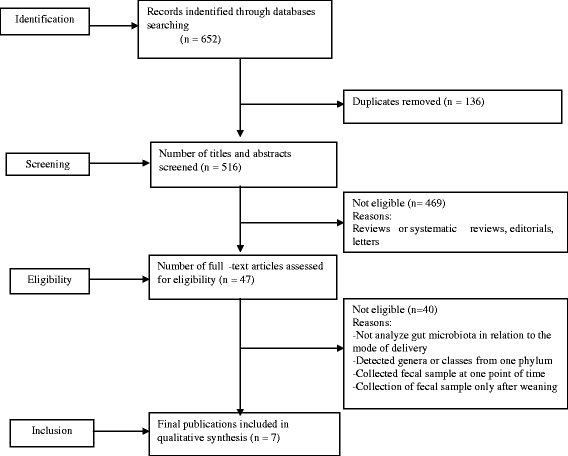The mode of delivery affects the diversity and colonization pattern of the gut microbiota during the first year of infants' life: a systematic review
- PMID: 27475754
- PMCID: PMC4967522
- DOI: 10.1186/s12876-016-0498-0
The mode of delivery affects the diversity and colonization pattern of the gut microbiota during the first year of infants' life: a systematic review
Abstract
Background: The human gut is the habitat for diverse and dynamic microbial ecosystem. The human microbiota plays a critical role in functions that sustain health and is a positive asset in host defenses. Establishment of the human intestinal microbiota during infancy may be influenced by multiple factors including delivery mode. Present review compiles existing evidences on the effect of delivery mode on the diversity and colonization pattern of infants gut microbiota.
Methods: Two investigators searched for relevant scientific publications from four databases (Pubmed, Medline, Embase, and Web of Science). The last search was performed on September 21, 2015, using key terms ((delivery mode OR caesarean delivery OR cesarean section OR vaginal delivery) AND (gut microbiota OR gut microbiome OR gut microflora OR intestinal microflora OR microbial diversity) AND (infants OR children)). All included studies described at least two types of gut microbiota in relation to delivery mode (caesarean section vs vaginal delivery) and used fecal samples to detect gut microbiota.
Results: Seven out of 652 retrieved studies met inclusion criteria, were included in systematic analysis. Caesarean Section (CS) was associated with both lower abundance and diversity of the phyala Actinobacteria and Bacteroidetes, and higher abundance and diversity of the phylum Firmicute from birth to 3 months of life. At the colonization level, Bifidobacterium, and Bacteroides genera seems to be significantly more frequent in vaginally delivered infants compared with CS delivered. These infants were more colonized by the Clostridium, and Lactobacillus genera. From the reports, it is tempting to say that delivery mode has less effect on colonization and diversity of Bifidobacteria, Bacteroides, Clostridium, and Lactobacillus genera from the age of 6 to 12 months of life.
Conclusion: The diversity and colonization pattern of the gut microbiota were significantly associated to the mode of delivery during the first three months of life, however the observed significant differences disappears after 6 months of infants life. The healthy gut microbiota is considered to promote development and maturation of the immune system while abnormal gut is considered as the major cause of severe gastrointestinal infections during the infancy. Further studies should investigate the diversity and colonization levels of infant gut microbiota in relation to the mode of delivery and its broad impact on infants' health at each stage of life.
Keywords: Bacteroides; Bifidobacterium; Caesarean section; Clostridium; Firmicutes; Gut microbiota; Infants; delivery mode; vaginal delivery.
Figures
References
-
- Landman C, Quevrain E: [Gut microbiota: Description, role and pathophysiologic implications]. Rev Med Interne 2015;37(6):418–23 - PubMed
Publication types
MeSH terms
LinkOut - more resources
Full Text Sources
Other Literature Sources
Medical
Miscellaneous


